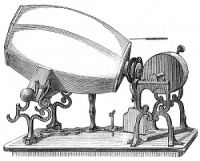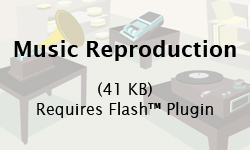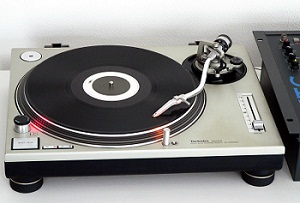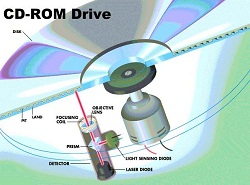Advancements in technology over the last 150 years have allowed people to spread music throughout the world by recording sound into a physical form and replaying it at their convenience. Music reproduction began in the late 19th century with the advent of the vinyl album, the first invention to let the masses record audio into a portable format. The vinyl album harnessed the complexity of sound waves by carving a waveform into grooves in a large disc. The next step in reproduction was the development of cassette tapes; using the same audio signals as vinyl records, cassette tapes selectively magnetized a continuous reel of tape, encoding music into a small compact package. Finally, the compact disc began its reign when digital technology advanced enough to allow the sampling and encoding of large amounts of music into an object about 1.2mm thick. These engineering marvels have allowed multiple generations to appreciate music and expand their cultural horizons with far more genres and bands than otherwise possible.
Music’s Pre-Vinyl History
Music has been a part of human history since the beginning of mankind. Initially, one had to be in the presence of the musician in order to hear the piece being played. With no way to reproduce or transport the songs, music was an entirely live experience taking place right then and there for the audience. Sheet music was invented in the 15th century as a method of notating exactly which notes should be played and for how long, enabling other musicians to replay what the composer created. Then, one orchestra could play the same song as another one across the country, but a live performance was still required to actually turn those notes into audible music.
The first device that enabled the recording of live music was the phonautograph (Fig. 1), invented in 1857 by Édouard-Léon Scott de Martinville, a French inventor. The device worked by funneling sound through a horn and then over a thin membrane, which was stretched tight like a drum. The membrane was attached to a small reed that engraved an image of the sound waves into a hand-cranked cylinder. While this device did not allow the user to play back the recording, it did set the standard for how to record music.
In 1877, Thomas Edison advanced the idea of the phonautograph with his own invention called a phonograph, which allowed the device to replay the recorded sound (Fig. 2). His invention followed the same basic principles as Scott de Martinville’s device, using a stylus moved by a vibrating membrane to etch waveforms into a rotating cylinder.
However, Edison’s creation could also replay the audio through a reverse process. To replay, the needle would move based on the scratches in the rotating cylinder, vibrating the membrane to produce a sound that was amplified through a large horn. These cylinders were eventually replaced with 7-16 inch diameter flat discs called albums or records [1]. See our flash animation video (Fig. 3) to visualize the phonautograph’s playback process.
Vinyl Albums
The vinyl albums that many are familiar with today stemmed from this evolution of mechanical sound reproductions. The gramophone of 1889 replaced the rotating cylinder with a flat vinyl disc rotated beneath the recording needle. This change essentially finalized the now-common disc design seen in records everywhere. In fact, even today many people are still snatching up records wherever they can find them because of the high sound quality and accompanying collector’s booklets [2].
So how is sound recorded onto vinyl albums? Sound is initially encoded into a soft material called lacquer using a sharp needle that carves spiral grooves into the circular base using a sound signal to guide it. Both sides of the lacquer are usually recorded upon in order to make the most use of the record’s size. When all of the desired sound is recorded, both lacquer layers are placed on either side of a polyvinyl chloride disc and sandwiched together, fusing them into the final product.
The spiral grooves are the key to reproducing the recorded sound and replaying it for the user. The record is placed on a turntable (Fig. 4), a flat surface with a rotating shaft in the center and a stylus similar to that found on a phonograph. As the turntable rotates the disc at a constant speed (decided based on the type of record), the stylus tracks the spiral grooves, vibrating with the fine inscriptions recorded into the lacquer (Fig. 5). These vibrations are transmitted back up the stylus and amplified by a tightened membrane, producing sound into a cone-shaped horn (Fig. 3).
This basic technology has remained the same for years, apart from a few minor changes along the way. For example, now most record players actually convert these vibrations into electric signals that are passed into a speaker system for amplification. This lets the user control more of the details of the sound, such as volume or digital effects. Another advanced trend that has become popular with audiophiles is that of laser reading for records. Just like a laser optical mouse, which uses an infrared laser to detect movement, this device shines a laser at the record and creates the sound signal based off of what data is reflected back to the receiver. The laser is also significant because it can actually read some damaged records, as it is able to register the grooves of the record without making physical contact [3].
Cassette Tapes
Magnetic cassette tapes were developed as a new way to record, distribute, and replay audio at a high fidelity. Commercialized in the late 1940s by John T. Mullin and pitched to Hollywood as a novel way to record movie soundtracks, the driving force behind the magnetic tape was actually actor Bing Crosby. Because of the high quality of the recording, Crosby was able to record his show ahead of time, freeing him from the pressures of live performance. As a result, he pitched a series of high-profile investments and endorsements that enabled this technology to become popular and widely-used throughout homes and inside automobiles [4].
Cassette tapes work with a long, thin strip of plastic (a standard tape is about 433 feet long, affording approximately 90 minutes of playtime). This strip is coated in a magnetic powder called ferric oxide (Fe2O3), as well as a dry lubricant to reduce abrasions against the tape. Music is recorded into the tape through a magnetic head that receives a signal from the sound source. As the signal fluctuates based on details in the audio, it powers an electromagnet that magnetizes the ferric oxide adjacent to the head. The tape scrolls past this head at 1.875 inches per second and records constantly as it goes. In order to double storage space, these tapes can also record a second track of audio running parallel and adjacent to the first one [5].
Playback works the exact same way as recording and even uses the same hardware. This time, as a point in the tape passes by the electromagnetic head, the magnetized ferric oxide layer inducts current back into the head. This current then passes to the speaker system, which uses it to produce sound (Fig. 3).
Cassette tape technology has proven to be quite versatile and has been employed for a variety of uses. For example, “multi-track recording” involves recording several sets of audio on each tape, allowing stereo or even surround sound playback by piping each of these tracks to an individual speaker [6]. These tapes can also be used as large-scale data storage for non-audio purposes. With current technology, a tape drive can store up to 1.5 terabytes of data and is often used by businesses as a reliable back-up solution for the company’s data [7].
Compact Discs
The compact disc, or CD, was developed by Sony and Philips as a new project in the early 1980s to revolutionize the digital audio scene. Much of this technology was built off of Philips’ earlier research into audio discs, then called Audio Long Plays. Sony contributed its hefty engineering might to this project and worked with Philips to design the detailed specifications of the compact disc into five books [8]. Between the two companies, a number of different engineering issues were approached and solved, including design decisions such as the sampling frequency and how to accurately store and reliably read a large volume of data. The CD was quickly accepted among the general population as a great replacement to the cassettes and albums the public was used to. Artists rapidly started converting their catalogs from analog to digital form for this new technology, and with this support the digital music revolution took off [9].
CDs work using digital signals instead of analog ones. In analog signals, values of a signal are measured in infinitely small values because every piece of the signal is used. However, in a digital system, the raw signal is only sampled once for each increment of time. For example, reading a signal at 6 Hz would mean taking a signal’s value six times per second, or once every one-tenth of a second. In addition, these values are stored entirely in binary representation using only 1’s and 0’s [10].
In terms of physical composition, a CD is constructed of three thin layers. The first is a protective plastic layer that allows users to print pictures or write on the disc. The second is a fine aluminum layer where the actual data of the disc is stored. Finally, the third layer is a clear plastic lacquer that covers the aluminum and gives the disc its shiny appearance. Data is stored on a CD through a series of indentations in the aluminum called bumps and stripes. These are organized in a tightly-wound spiral moving from the center of the disc outwards [11].
Data is read off the CD using a laser. As the disc spins, the laser shines on the disc and reflects back into a sensor (Fig. 6). If the laser shines on a bump, it scatters away from the sensor, registering as a “0” to the audio system. However, if it hits a smooth stripe, the beam reflects into the sensor, which notes that position as a “1”. By accumulating massive quantities of “1”s and “0”s, a digital-to-analog converter can reconstruct this digital signal into an analog one that can be used by speakers to create music [12].
In order to retain high audio quality, the system must be able to recreate the original analog signal as closely as possible. As mentioned earlier, digital signals are created by sampling the value of the original sound at certain increments. Shannon’s Sampling Theorem, a standard equation used in signal processing, states that in order to exactly recreate an analog signal, the signal must be sampled at a rate that is at least twice the value of the highest frequency found in the signal [13]. Because the human ear can generally only hear frequencies up to about 20 kHz (20,000 Hz), this would mean that a CD would have to be sampled at at least 40 kHz. Incidentally, the universal sampling frequency for CDs is 44.1 kHz, more than enough to recreate the original sound at high quality.
The Digital Future
Today, music reproduction has transitioned overwhelmingly into digital recordings, stored as MP3 files on computers. With the ability to buy songs from online stores like iTunes, people have recently traded in their CDs in favor of convenience and the ability to purchase individual songs. As a result, CD sales are slowly slipping as more digital songs are purchased each year. According to Nielsen studies, 2009 was part of a nine-year slide in CD sales, whereas online song downloads during the same period have increased by 37%, often attributed to consumers’ desire for music instantly and affordably [14]. Given these trends, it is estimated that by 2012 digital downloads will finally eclipse CDs in terms of sales income. Luckily though, society has always had a niche for the older technologies, whether it is the audiophile with the album collection, the teenager with the tape deck in his old car, or families replaying CDs accumulated over the years. These are all still timeless treasures in the musical world; without the development of these technologies, the progression to today’s digital downloads would not be possible. After reading this article, hopefully you too can appreciate the admirable engineering accomplishments that allow you to hear your favorite band from Europe playing in your room in California without having to break a sweat.









